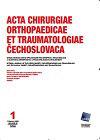Crowe II型和III型髋关节发育不良的高髋关节中心与解剖重建技术的比较:一项回顾性临床研究。
IF 0.4
4区 医学
Q4 ORTHOPEDICS
Acta chirurgiae orthopaedicae et traumatologiae Cechoslovaca
Pub Date : 2022-08-15
DOI:10.55095/achot2022/044
引用次数: 2
摘要
关于全髋关节置换术(THA)中的高髋关节中心(HHC)重建是否是严重发育性髋关节发育不良(DDH)患者的理想选择,文献存在争议。本研究旨在比较在Crowe II型和III型DDH中使用HHC和解剖髋关节中心(AHC)技术进行THA的中期功能和放射学结果。我们的假设是,使用HHC或AHC进行THA的患者在功能和放射学结果方面可能没有差异。材料和方法对57例因Crowe II型或III型DDH而接受原发性THA的患者进行回顾性分析。根据髋关节中心重建将患者分为两组:A组(AHC技术)和H组(HHC技术)。在A组AHC附近的25个髋关节(19名女性,6名男性;平均年龄=51岁,年龄范围=28-67)和H组HHC位置的32个髋关节中插入非水泥杯。为了评估临床状态,在最后的随访中使用Harris髋关节评分(HHS)。在放射学评估中,髋臼杯的部件松动和骨整合在后续的放射学检查中进行了检查。并发症也有记录。结果A组平均随访41个月(25~84),H组平均随访40个月(24~86)。A组平均HHS为83(74~91);H组平均HHS为83.6(73~94)(p=0.741)。其他51个杯子显示了至少一个骨整合的放射学迹象。尽管A组的总并发症发生率(64%)高于H组(46%),但这一差异没有统计学意义(p=0.11)。结论在Crowe II型和III型DDH的病例中,使用非骨水泥髋臼内固定的HHC技术似乎是AHC技术的一个有价值的替代选择。关键词:高臀中心;解剖髋关节中心;旋转中心;全髋关节置换术;髋关节发育不良;发育性髋关节发育不良;Crowe II型;Crowe III型。本文章由计算机程序翻译,如有差异,请以英文原文为准。
Comparison of High Hip Center versus Anatomical Reconstruction Technique in Crowe Types II and III Developmental Dysplasia of the Hip: a Retrospective Clinical Study.
PURPOSE OF THE STUDY The literature is conflicting as to whether the high hip center (HHC) reconstruction in total hip arthroplasty (THA) is an ideal option for patients with severe developmental dysplasia of the hip (DDH). This study aimed to compare the mid-term functional and radiographic outcomes of THA using HHC versus anatomical hip center (AHC) technique in Crowe types II and III DDH. Our hypothesis was that there may be no differences in terms of functional and radiographic outcomes between patients who underwent THA using HHC or AHC. MATERIAL AND METHODS Fifty-seven patients who underwent a primary THA due to Crowe type-II or type-III DDH were retrospectively reviewed and included. Patients were divided into two groups as per the hip center reconstruction: Group A (AHC technique) and group H (HHC technique). A cementless cup was inserted in 25 hips (19 female, 6 male; mean age = 51 years, age range = 28-67)) at near-AHC in group A and 32 hips (22 female, 10 male; mean age = 53 years, age range = 29-68) at HHC position in group H. To assess clinical status, the Harris Hip Score (HHS) was used at the final follow-up. In radiographical assessment, component loosening and osseointegration of the acetabular cup were examined on follow-up radiographs. Complications were also recorded. RESULTS The mean follow-up was 41 months (range, 25-84) in group A and 40 months (range, 24-86) in group H. The mean HHS was 83 (range, 74-91) in group A and 83.6 (range, 73-94) in group H (p = 0.741). Osteolysis was determined in three patients from each group. The other 51 cups demonstrated a minimum of one radiographic sign of osseointegration. Although the overall complication rate was higher in group A (64%) than in group H (46%), this difference reached no statistical significance (p = 0.11). CONCLUSIONS The HHC technique using cementless acetabular fixation seems to be a valuable alternative option to AHC technique in cases of Crowe types II and III DDH. Key words: High hip center; anatomical hip center; center of rotation; total hip arthroplasty; dysplastic hip; developmental dysplasia of the hip; Crowe type II; Crowe Type III.
求助全文
通过发布文献求助,成功后即可免费获取论文全文。
去求助
来源期刊
CiteScore
0.70
自引率
25.00%
发文量
53
期刊介绍:
Editorial Board accepts for publication articles, reports from congresses, fellowships, book reviews, reports concerning activities of orthopaedic and other relating specialised societies, reports on anniversaries of outstanding personalities in orthopaedics and announcements of congresses and symposia being prepared. Articles include original papers, case reports and current concepts reviews and recently also instructional lectures.

 求助内容:
求助内容: 应助结果提醒方式:
应助结果提醒方式:


